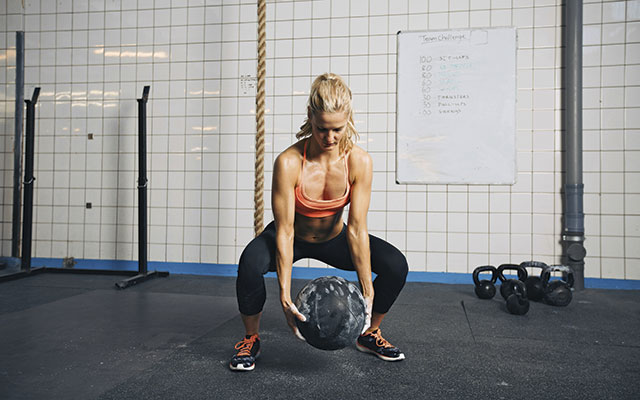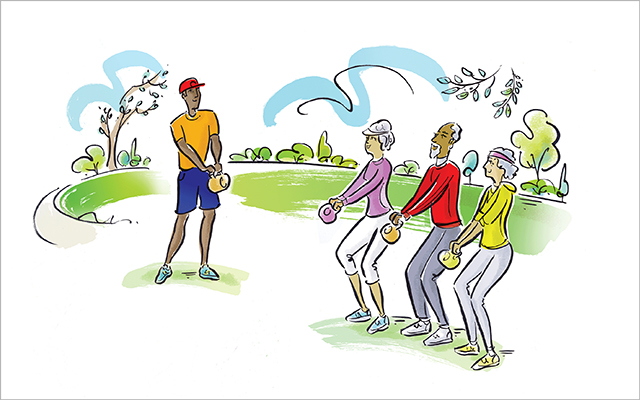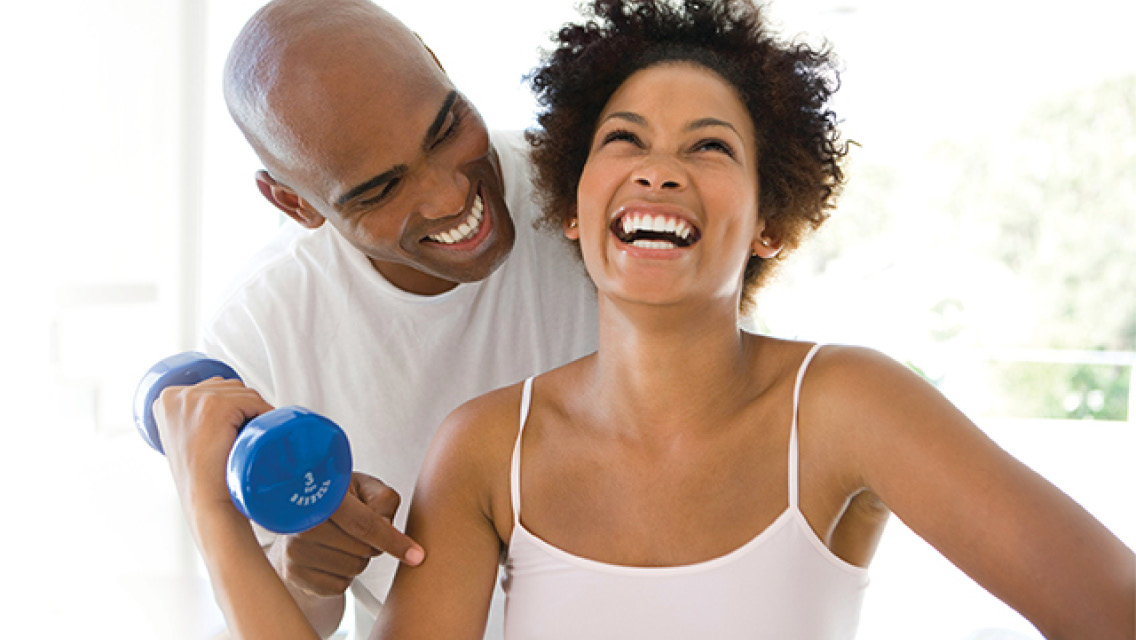Jump to Smart Swaps: 7 Functional Moves
You probably remember the day the strange bouncy balls showed up in your gym.
Back in the 1990s, those colorful rubber playthings seemed out of place among all the iron and steel, the real workout gear.
But many of us quickly found uses for these big orbs: sitting on them to press or curl, or lying on them to crunch our abs or extend our backs.
The arrival of those balls, now a staple in gyms everywhere, marked most people’s first exposure to “functional training.”
As the name suggests, functional training emphasizes how your body functions — what it can do and how you can learn to do it better. It’s a broad, progressive, and health-centered approach to fitness that’s flexible enough to address the needs of regular exercisers and high-level athletes alike.
Since it doesn’t focus myopically on how you look, in many ways it’s the antidote to what ails the vanity-driven fitness industry.
And yet, ironically, functional training can also improve your appearance faster than the aesthetic strategies championed by the fitness gurus on many infomercials.
“We train people in the context of what they want and need to do,” says Gary Gray, PT, founder of the Gray Institute and a sought-after performance coach for elite athletes. “And it’s always with the understanding that they are three-dimensional people, not just a collection of muscles.”
The Functional Imperative
“Two hundred years ago, people didn’t need functional training,” says Gray Cook, MSPT, OCS, CSCS, founder of Functional Movement Systems and author of Movement and Athletic Body in Balance. Just getting through a day of farming or blacksmithing would have provided a challenge to our functional fitness.
“We come from a history where life was dependent on movement skills — and that was enough to keep us fit,” he adds. Today, it’s a different story. “We’re no longer adapting to our environment,” Cook says. “We’re adapting our environment to us, and very few of us rely daily on movement skills.”
And while an ergonomic environment makes life more comfortable, it can also be tough on our health and fitness.
“Starting at about age 6, we’re all basically told to sit down and shut up for 12 years,” says Gray. “So we grow up suffering from ‘proprioceptive inhibition’” — or a dulled ability to sense the world around us. Easy chairs and couches have made poor posture and “computer slouch” nearly universal. Flat sidewalks and handrails have made good balance almost unnecessary. Cars have made it easy to get through a day without walking far, and we rarely have to lift or climb anything. The result has been a steep decline in our capacity to learn and refine movement.
“When you move poorly,” says Cook, “your learning pathways are unable to align, feel, and respond to whatever is happening. It’s like you’ve shown up to art class wearing sunglasses. You’re colorblind.”
Most standard exercise programs are based on repetitious movement and supported by equipment that helps us work around weak spots rather than making them strong. So, they do little to address the problem — and sometimes compound it.
“People who exercise think they’re getting across-the-board improvements in fitness — but a lot of times they aren’t,” says Cook. “If you pursue strength or weight loss without some kind of systematic approach, you’ll often end up out of balance.”
“People who exercise think they’re getting across-the-board improvements in fitness — but a lot of times they aren’t,” says Cook. “If you pursue strength or weight loss without some kind of systematic approach, you’ll often end up out of balance.”
Running, for example, can improve your endurance and cardiovascular health, but if you do it every day in running shoes that desensitize your feet to the forces traveling through your skeleton, you may compromise posture, alignment, and strength.
If you use a leg-press machine, you may build leg strength you can’t support with your back and core, making you more likely to pull a hamstring or herniate a disk when you lift something heavy outside the gym.
What most of us need is a progressive, systematic, and sensory-rich exercise system that helps to rebuild a foundation of movement skills supporting whatever goals we may wish to pursue — aesthetic or athletic.
Crawl, Walk, Run
Functional training often looks like other types of training: If you’ve ever done whole-body, ground-based exercises like squats, lunges, or pushups, for example, you’ve already done moves that most coaches would consider “functional.”
In truth, however, functional training is much broader than any class or type of exercise, says Gray. “Technically speaking, anything you want to do, and that your body can do, is functional.”
What distinguishes proper functional training is the purpose of each exercise and the context in which you perform it.
“Years ago, people went to the gym to learn a skill or overcome a physical obstacle, and a high level of physical fitness was a side effect,” says Cook. “Now, we’re pursuing a side effect and short-circuiting the learning process.”
Functional coaches seek to restore the educational aspect of physical education. They make each exercise session a learning experience for the body, not just a stimulus for the muscles, with each rep a small step toward the larger goal of mastering some physical skill — whether that skill is dunking a basketball or simply playing with your grandkids without getting winded.
To that end, a functional program begins simply, with tests of movement competency, in which the client performs basic, developmental movements like squatting, reaching, lunging, balancing, and crawling to give the coach a baseline reading of the client’s balance, alignment, coordination, symmetry, and mobility.
If a glaring asymmetry or limitation exists — you lunge well on one side but not on the other, for example — the coach might focus on ironing out the discrepancy before moving on to other goals or concerns. In this way, basic movement limitations don’t hold you back or put you at risk for injuries as you start to perform more challenging exercises with greater intensity.
“First move well,” says Cook. “Then move often.”
A Well-Rounded Approach
After you have mastered the basics, you can start to perform movements that are increasingly complex, working many muscles at once and using as many different angles and planes of motion as possible to maximize carryover to everyday activities. (For sample exercises, see “Getting Ultra Fit”.)
“What we’re after is general-purpose physical capacity,” says Cook. Too much of any single activity — the same angle, the same movement, the same type of load — will ultimately cause limitations and, potentially, injuries.
Human beings, explains Gray, are three-dimensional: “We’re capable of moving in three planes of motion — forward and back, side to side, and rotationally. But it goes further than that: We’re also muscles, bones, and nerves. We can express strength, endurance, and power. And we’re mind, body, and spirit. If we leave any of those dimensions out, then we’re not training the whole person.”
A single-joint exercise like a leg curl — a hamstring exercise where you lie face-down on a machine and draw your heels toward your pelvis under resistance — is one-dimensional, explains Gray. “It works a single joint in a context that is completely artificial. The hamstring doesn’t even function that way when you run or jump or walk.” So the carryover to everyday activity is almost zero.
The most effective exercises require you to move your body — rather than a machine lever — through space in a way your body recognizes as active and functional. Generally, that means at least one of your feet should be on the ground, and many, if not most, of your joints should have to move or stabilize as you execute the move. Classic exercises like deadlifts and body-weight rows are great examples. Biceps curls and lateral raises are not.
Over time, you might graduate to single-leg deadlifts and one-arm body-weight rows, perhaps with twists or reaches. (For a breakdown on trading in some isolation moves for functional ones, see “Smart Swaps” below.)
The best functional exercises provide instant feedback when you’re doing them incorrectly. Cook refers to such moves as self-limiting, because no one needs to tell you when your form has deteriorated: Make a wrong step while traversing a balance beam or skipping rope, for example, and you simply fall off the beam or step on the rope. Low-skill activities like jogging and stationary cycling have no such “off” switch, so it’s comparatively easy to hurt yourself.
“Regardless of your strength and athleticism,” he says, “the better you do a self-limiting exercise, the more you can do.”
Self-limiting exercises thus ensure your sensory-motor abilities continue to evolve along with strength, endur-ance, power, and speed: They’re movement puzzles you can come back to again and again to keep your nervous system tuned up and ready for new challenges.
Move Better, Look Better
In a system that focuses on health and performance, aesthetic concerns like your dress size or the contours of your biceps are secondary — but that doesn’t mean that functional training doesn’t improve them.
On the contrary: Function is the rising tide that raises all ships. Improve function and your appearance improves. Aches and pains begin to dissipate. Strength, alignment, and balance become harmonized. And you move with more fluidity and confidence, in the gym, on a playing field, or simply through your day.
At the same time, muscles firm up, fat burns away, and you wind up looking significantly better — not because you’ve isolated muscle groups and cardioed yourself to an “ideal” weight, but because you’ve learned to move with more efficiency and athleticism.
“We’re all obsessed with looking like the statue of David,” says Cook. “But the prize we have our eye on shouldn’t be to look like that guy, but to do what that guy did to look like that. Because when you train for function, an all-round strong body is the natural outcome.” Form follows function.
Smart Swaps: 7 Essential Functional Moves
Here’s how to replace isolation moves with more effective functional alternatives.
You don’t just want to perform well. You want to look good, too. So you do isolation exercises like curls and crunches in hopes that you’ll build this part up or whittle that one down.
Surprise! It’s impossible to isolate individual muscle groups.
“Like the song says,” quips Gary Gray, PT, “the foot bone’s connected to the leg bone.” The moment one muscle group turns on, he explains, several others jump in on the act.
Rather than doing one move for your biceps, another for your abdominals, and so on, it’s far more effective and efficient to choose exercises that call on many muscle groups to work together, just as they do when you walk, run, or play sports outside the gym.
1) Body-Weight Row
[Instead of Biceps Curl]
Grab the handles of a TRX with your palms facing one another, and lean backward so your arms are straight and you’re facing up. Keeping your body straight from your heels to your head, engage your shoulder blades and pull yourself up until your hands are close to the sides of your rib cage. Pause for a moment, then lower yourself to the starting position.
Too tough? Take a step back to stand more upright. Too easy? Walk your feet forward.
Functional Value: Climb ladders or steep surfaces, and lift, carry, and grip heavy objects. Also enhances your posture and shoulder health.
2) Pushup
[Instead of Chest Press Machine]
Assume a plank position, hands under your shoulders and toes planted on the floor. Keeping your body straight, your core engaged, and your neck in a neutral position, lower your body toward the floor until your elbows form 90-degree angles. Then push yourself back up to the starting position, maintaining a straight line from your heels to your head.
Too tough? Elevate your hands on a sturdy surface. Too easy? Elevate your feet.
Functional Value: Get up off the floor more easily, push a child or heavy object overhead, or catch yourself when you fall.
(Fine-tune your form in this fundamental upper-body move at “How to Do the Pushup.”)
3) Push Press
[Instead of Lateral Raise]
Lift two dumbbells or kettlebells to shoulder height, hands roughly parallel, and stand with your feet shoulder-width apart. Bend your legs slightly, then explode up forcefully as if jumping, extending your hips, knees, and ankles while simultaneously lifting the dumbbells overhead as quickly as you can. Pause, then lower the weights back to shoulder height.
Functional Value: Carry or lift objects at or above shoulder height. Throw, strike, or hit in sports like tennis, softball, basketball, and boxing.
4) Bear Crawl
[Instead of Stationary Cycling]
Assume an all-fours position, hips over your knees, shoulders over your hands. Lift your knees slightly from the ground. Keeping your feet parallel to each other and your back parallel to the ground, step your right hand and your left foot forward. Repeat with the left hand and right foot. Continue moving forward, backward, and sideways in this same manner.
Functional Value: Comfortably play with children on the floor, walk or run with greater efficiency, and perform everyday movements with less back pain.
(See “How to Do the Bear Crawl” for more form tips and a quick video demo of the move.)
5) Kettlebell Sumo Deadlift
[Instead of Leg Curl]
Assume a wide stance with your feet slightly more than shoulder-width apart and with a heavy kettlebell between your feet. Keeping your chest up and your lower back in its natural arch, bend at the hips and knees and grasp the kettlebell with a double-overhand grip. Push down through your heels and rise to standing, pause, then reverse the movement.
Functional Value: Safely lift heavy objects or children from the floor, sit more comfortably, and run and walk more efficiently.
(Here are seven variations and video demos of this powerful move.)
6) Farmer’s Walk
[Instead of Crunches]
Holding two heavy dumbbells or kettlebells by your side, with chest up and shoulders back, walk forward at a controlled pace.
For a variation, you can hold one or both weights at shoulder height or overhead. (Explore the variations of this funcational move at “How to Do the Kettlebell Carry.”)
Functional Value: Walk, sit, and move with better posture. Avoid or relieve back pain. Carry groceries, suitcases, and other heavy objects.
7) Jump Rope
[Instead of Elliptical Machine]
Jumping rope is a great all-around functional exercise. If you don’t know how to jump rope, ask a trainer to show you how. Proper form is key.
For a variation, try hopping on one foot, alternating feet, crossing your arms as the rope comes overhead, or doing double unders — two revolutions per jump.
Functional Value: Run and jump more explosively, build athletic stamina, hold good posture with greater ease, and coordinate upper- and lower-body movement more efficiently.
(Ready to transform jumping rope from child’s play to a fat-burning, coordination-building workout? Try this Jump-Rope HIIT Workout to start!)




This Post Has 0 Comments